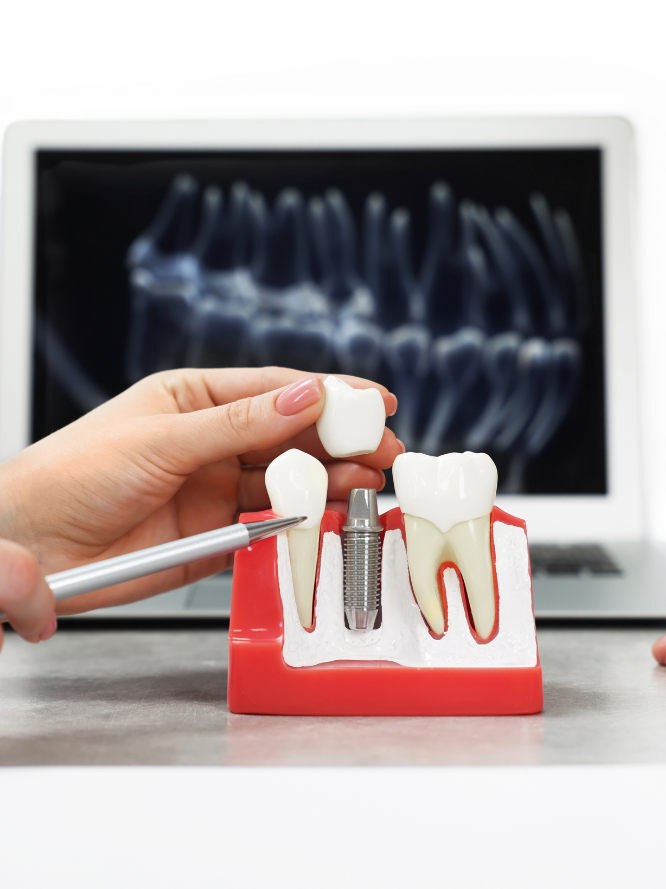Losing a tooth, whether due to decay, injury, or gum disease, impacts your oral health, confidence, and quality of life. Fortunately, modern dentistry offers incredibly effective and long-lasting solutions for tooth replacement.
Among these, dental implants are celebrated for their ability to replicate the look, feel, and function of natural teeth. They are widely considered one of the most reliable and durable choices for missing teeth.
Despite their popularity and high success rates, many patients considering dental implants often hesitate due to misinformation.
If you’re exploring cosmetic dentistry near you and wondering what to know before dental implants, read on as we debunk these common misconceptions.
Myth #1: Dental Implants Are Painful
Most patients report minimal discomfort during and after the dental implant procedure. The idea that it’s an excruciating experience is largely a myth rooted in outdated perceptions of dentistry.
During the procedure, your dentist will use local anesthesia to completely numb the area. You might feel some pressure or vibration, but you should not feel any sharp pain.
For patients with dental anxiety, sedation options (like oral conscious sedation or IV sedation) are often available to help you relax throughout the appointment.
As with any surgical procedure, some post-operative soreness, swelling, or mild discomfort is normal once the anesthesia wears off. This is typically manageable with over-the-counter pain medication or, if needed, a prescription pain reliever provided by your dentist.
Most patients compare the discomfort to that of a tooth extraction. At the end of the day, modern implant techniques and pain management strategies make the procedure highly tolerable for the vast majority.
Myth #2: Dental Implants Look Fake
A natural-looking result is a primary concern for anyone investing in cosmetic dentistry. The truth is that implants are meticulously custom-made to match your natural teeth in terms of color, shape, and size.
The visible part of the implant, aka the crown, is typically crafted from high-quality, durable materials like porcelain to mimic the translucency and luster of natural tooth enamel.
Modern dental technology, like 3D imaging and digital impressions, means precise planning and fabrication. Your new crown will blend seamlessly with your existing teeth, taking into account factors like your bite, gum line, and overall facial aesthetics.
An experienced implant dentist will work to make your implant indistinguishable from your natural teeth. In fact, many people cannot tell the difference between a well-placed dental implant and a real tooth.
Myth #3: Implants Are Only for Older Adults
There’s a misconception that dental implants are exclusively for the elderly who may have lost multiple teeth. In reality, adults of all ages can benefit from dental implants, provided they meet the necessary health criteria.
Ideal candidates for dental implants are typically individuals with good general and oral health, sufficient bone density in the jaw to support the implant, and healthy gum tissue free of periodontal disease.
Implants are an excellent solution for anyone missing one tooth, several teeth, or even all teeth. They are used to replace teeth lost due to accidents, congenital conditions, or disease, regardless of age (once jaw growth is complete, typically in late teens/early twenties).
Myth #4: The Procedure Is Too Risky
Any surgical procedure carries some inherent risk, leading some to believe that dental implant surgery is fraught with danger. Truthfully, dental implants boast an exceptionally high success rate, often quoted at 95% or higher.
When performed by an experienced, qualified dentist or oral surgeon, risks associated with dental implant surgery are minimal. These professionals undergo extensive training in surgical techniques, anatomy, and implantology to minimize potential complications.
Before any surgery, a comprehensive evaluation is conducted. This includes detailed imaging (X-rays, CT scans) to assess bone structure, nerve locations, and sinus cavities. Meticulous planning helps avoid potential pitfalls and reduces the risk of complications.
Complications, when they do occur, are usually minor and manageable, like localized infection or temporary numbness, similar to side effects of other minor oral surgeries.
Myth #5: Implants Are Too Expensive
The upfront cost of dental implants can seem higher than other tooth replacement options, leading to the perception that they are unaffordable. In actuality, though the initial investment may be greater, dental implants often prove more cost-effective in the long term.
Unlike bridges or dentures, which may require adjustments, repairs, or replacements every 5-10 years, dental implants are designed as a permanent solution.
With proper care, dental implants last 20 years, a lifetime, or even more, saving you money on future replacements, relines, or adhesives. Over decades, the cumulative cost of maintaining bridges or dentures can easily surpass that of implants.
Implants also help preserve surrounding teeth and bone. Bridges require grinding down adjacent healthy teeth for support, which can weaken them over time. Dentures can accelerate bone loss in the jaw. Implants prevent these issues, saving on potential future dental work.
Finally, most dental practices nowadays offer various financing options, payment plans, or accept dental insurance that may cover a portion of the cost.
Myth #6: Recovery Takes Forever
Most patients return to their normal activities within a few days of the implant procedure. While initial soreness and swelling might last for a few days, most people resume light activities within 24-48 hours. Any discomfort is generally well-managed with medication.
The longer part of recovery involves osseointegration, the biological process where the implant fuses with the jawbone. This critical healing phase typically takes 3 to 6 months. However, this process occurs beneath the gum line and does not significantly affect daily life. You can eat soft foods and carry on with most normal activities.
Following your dentist’s post-operative instructions carefully, like avoiding hard, chewy foods initially, practicing good oral hygiene, and refraining from smoking, can significantly speed up healing.
Myth #7: You Can’t Get Implants If You’ve Lost Bone
Bone loss in the jaw is a common consequence of missing teeth or periodontal disease, and it used to be a significant barrier to dental implant placement. Thanks to modern technology and techniques, bone grafting or sinus lifts can make implants possible for many patients with bone loss.
If you have insufficient bone density in your jaw, your dentist can perform a bone grafting procedure, adding bone material (from your own body, a donor, or synthetic material) to the jawbone to stimulate new bone growth. Once the grafted bone has integrated and hardened (typically a few months), there is enough support for an implant.
For implants in the upper jaw, especially near the molars, the sinus cavity might be too close to the jawbone. A sinus lift procedure gently raises the sinus floor and adds bone material, creating the necessary space.
Thanks to these sophisticated pre-implant procedures, many patients who were previously told they were not candidates for dental implants are now able to successfully receive them. A thorough evaluation, including advanced imaging, can determine your best options and whether these preparatory procedures are needed.
Dental Implants in West Hills, CA
Don’t let outdated dental implant myths and facts keep you from exploring one of the most effective and long-lasting tooth replacement solutions available today!
Dental implants offer a remarkable opportunity to restore your smile, improve your chewing function, prevent bone loss, and boost your overall confidence.
If you’re missing teeth or are considering your options for cosmetic dentistry near you, the best first step is to speak directly with an experienced dental implant dentist. Request an appointment at West Hills Smiles today to get started.




